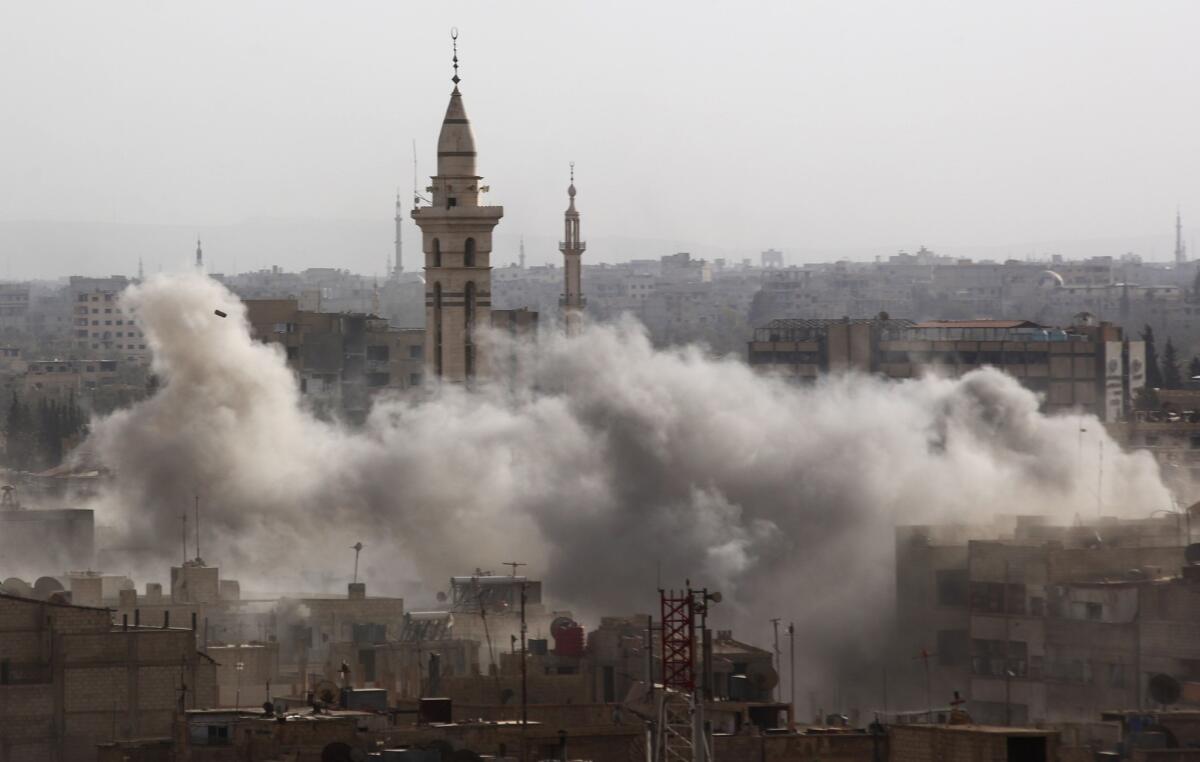Pentagon denies U.S.-trained rebels defected to Al Qaeda affiliate in Syria

Smoke billows from the rebel-held area of Duma, northeast of the Syrian capital, Damascus, after a reported airstrike by government forces on Sept. 16.
- Share via
Reporting from Washington — The Pentagon said Wednesday that there is no evidence that a U.S.-trained and equipped proxy force in Syria has defected to an Al Qaeda affiliate.
The denial comes amid a flurry of reports and social media posts that a U.S.-backed commander, along with 70 fighters, had joined the Al Qaeda-affiliated Al Nusra Front, after receiving training and a cache of weapons in neighboring Turkey.
The reports of the defection came two days after the Pentagon confirmed that a group of about 70 fighters returned to Syria after combat training in Turkey as part of the U.S. program to train and equip rebels to confront Islamic State extremists.
Capt. Jeff Davis, a Pentagon spokesman, said Wednesday that the defection claims were “patently false” and that the U.S. military remains in contact with the newly trained fighters, whose weapons were all accounted for.
U.S. Central Command, which oversees military operations in the Middle East, also confirmed that “coalition-issued weapons and equipment are under the positive control” of the so-called New Syrian Force fighters.
The developments were the latest twist in the U.S. military’s $500-million program to train and equip 5,400 Syrian rebel fighters who are considered moderate. The plan has been beset with problems since it was announced by President Obama more than a year ago.
A U.S.-trained rebel group in Syria known as Division 30 posted a statement on Facebook saying it was investigating claims that two purported members of Al Nusra Front reported the U.S.-trained rebels had surrendered to the group as soon as they crossed into Syria.
After training in Turkey, they entered the northern province of Aleppo early Saturday morning with a dozen “technicals,” pickup trucks with machine guns attached, and a cache of arms and ammunition, according to the Syrian Observatory for Human Rights, a pro-opposition monitoring group.
An Al Nusra Front member with the nom de guerre Abu Khattab Maqdisi said on Twitter that the group’s commander, Anas Obaid -- also known as Abu Zaid -- had “sat with Al Nusra Front and clarified what he wanted to do in terms of tricking the coalition and entering Syria with the weapons only because he needed them.
“And he promised to issue a statement repudiating himself from Division 30, the coalition, and those who trained him and not to repeat his actions,” the Al Nusra Front member said, “and he gave a large amount of weapons to Al Nusra Front.”
On Tuesday, a statement issued by Abu Zaid declared the break with Division 30 and that his group, the Gathering of the Revolutionaries of Atarib, was “an independent faction” that would have no coordination with Division 30 or the international coalition against Islamic State.
A spokesman for the Atarib-based rebel faction said in an interview that the group had handed some equipment over to Al Nusra Front, Al Qaeda’s affiliate in Syria.
“To prevent any clashes between us [and Al Nusra Front], and since we were in areas not our own and had just entered Syrian territories, we handed over to Al Nusra Front five pickup trucks with machine guns attached to them and only less than a quarter of the ammunition, so as to prevent fighting between the two sides,” said the spokesman, who goes by the nickname Mohammad Ataribi.
He denied any arms had been handed over to the Al Qaeda affiliate, however, and insisted the group had joined the training program in goodwill, though it could not be independently verified.
“We went through the training to coordinate and fight [Syrian President Bashar Assad’s] regime and Daesh,” the spokesman said, referring to Islamic State by its Arabic acronym. “But after we reached Syria there were some problems that made us break our connection with the international coalition.”
A Division 30 member on Twitter also said Wednesday that no weapons had fallen into the hands of the extremists. Meanwhile, Al Nusra Front supporters uploaded pictures of assault rifles reportedly taken from Division 30.
The Pentagon’s train and equip program started in May after months of delays and disagreements about its goal.
The four countries where the military training would take place — Turkey, Jordan, Saudi Arabia and Qatar — wanted the training to focus first on ousting Assad, while the White House wanted the fighters to target Islamic State.
Rebel trainees, meanwhile, chafed under a condition that they engage Islamic State and abandon the fight against government forces. Others quit or did not pass a difficult vetting process.
Gen. Lloyd J. Austin III, who heads U.S. Central Command, told the Senate Armed Services Committee last week that the program had generated only “four or five” coalition-trained fighters in Syria after the initial class of 54 was ambushed by Al Nusra Front.
The military said nine fighters have since returned to Syria; 14 have returned to Syria but quit the program; 11 left Syria altogether, and 18 are missing. Of the remaining two, one was killed and the other was captured by Al Nusra Front.
Times staff writer Hennigan reported from Washington and special correspondent Bulos from Amman, Jordan.
Follow @wjhenn for military and defense info.
ALSO
U.S. commander says only 4 or 5 Pentagon-trained fighters in Syria
New U.N. probe of Syrian chemical weapons use to name perpetrators
Aid groups see ‘dramatic’ increase in donations after death of Syrian toddler
More to Read
Sign up for Essential California
The most important California stories and recommendations in your inbox every morning.
You may occasionally receive promotional content from the Los Angeles Times.













